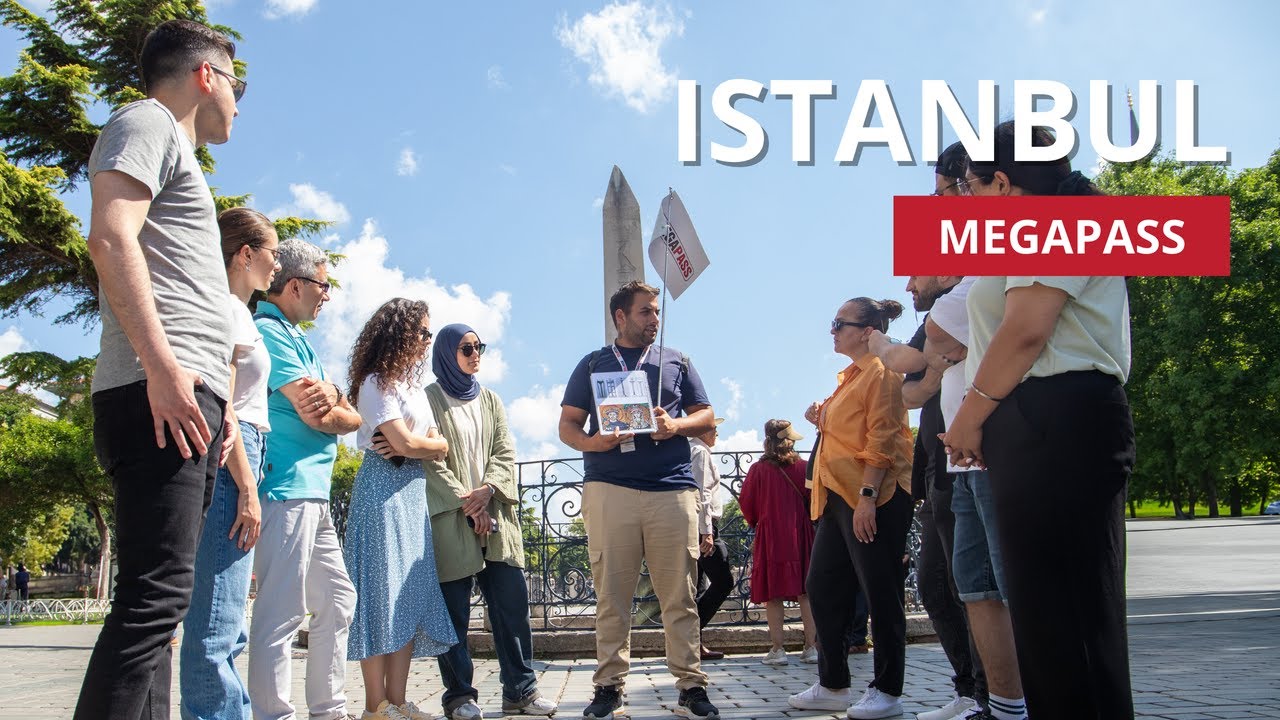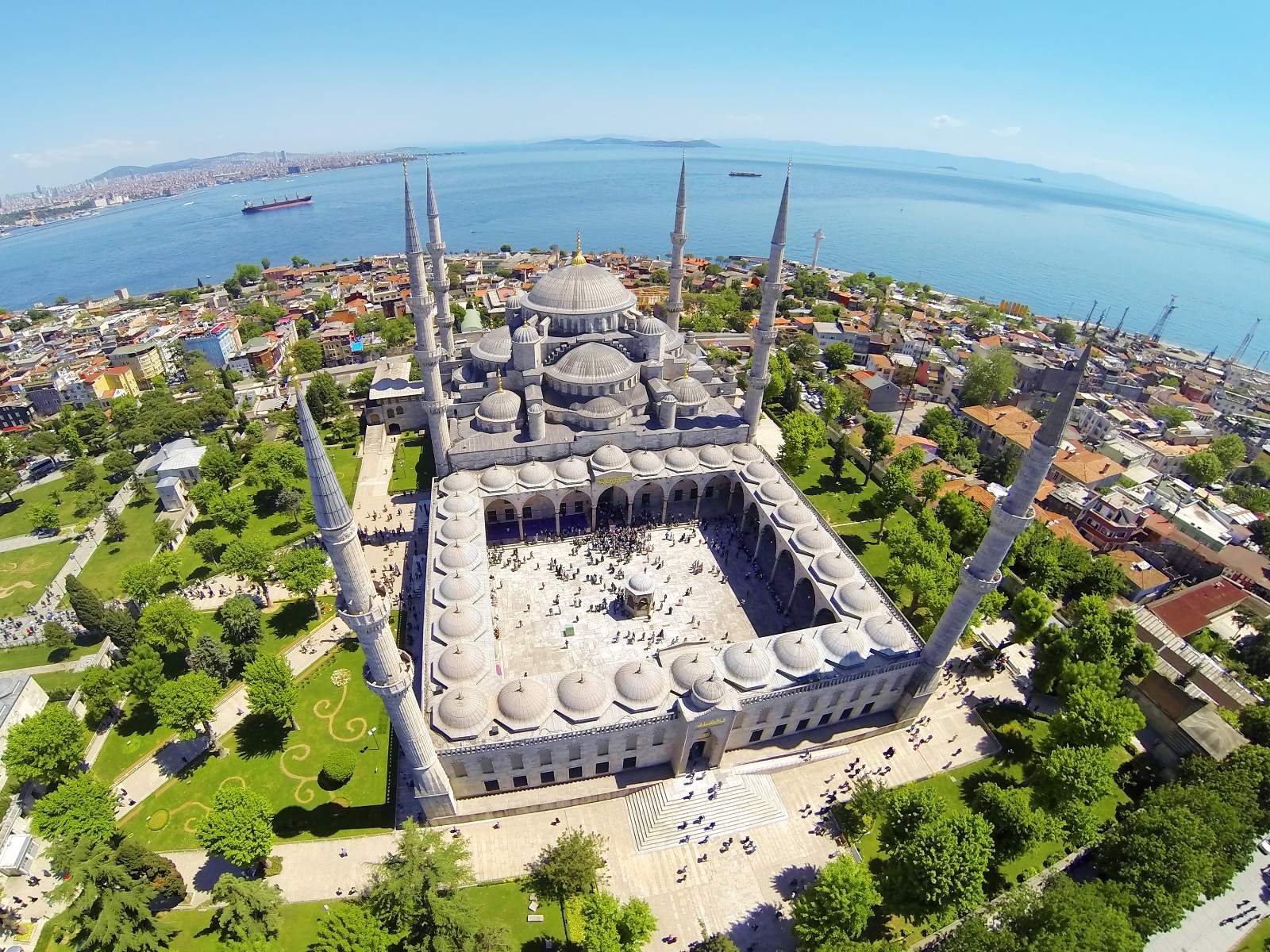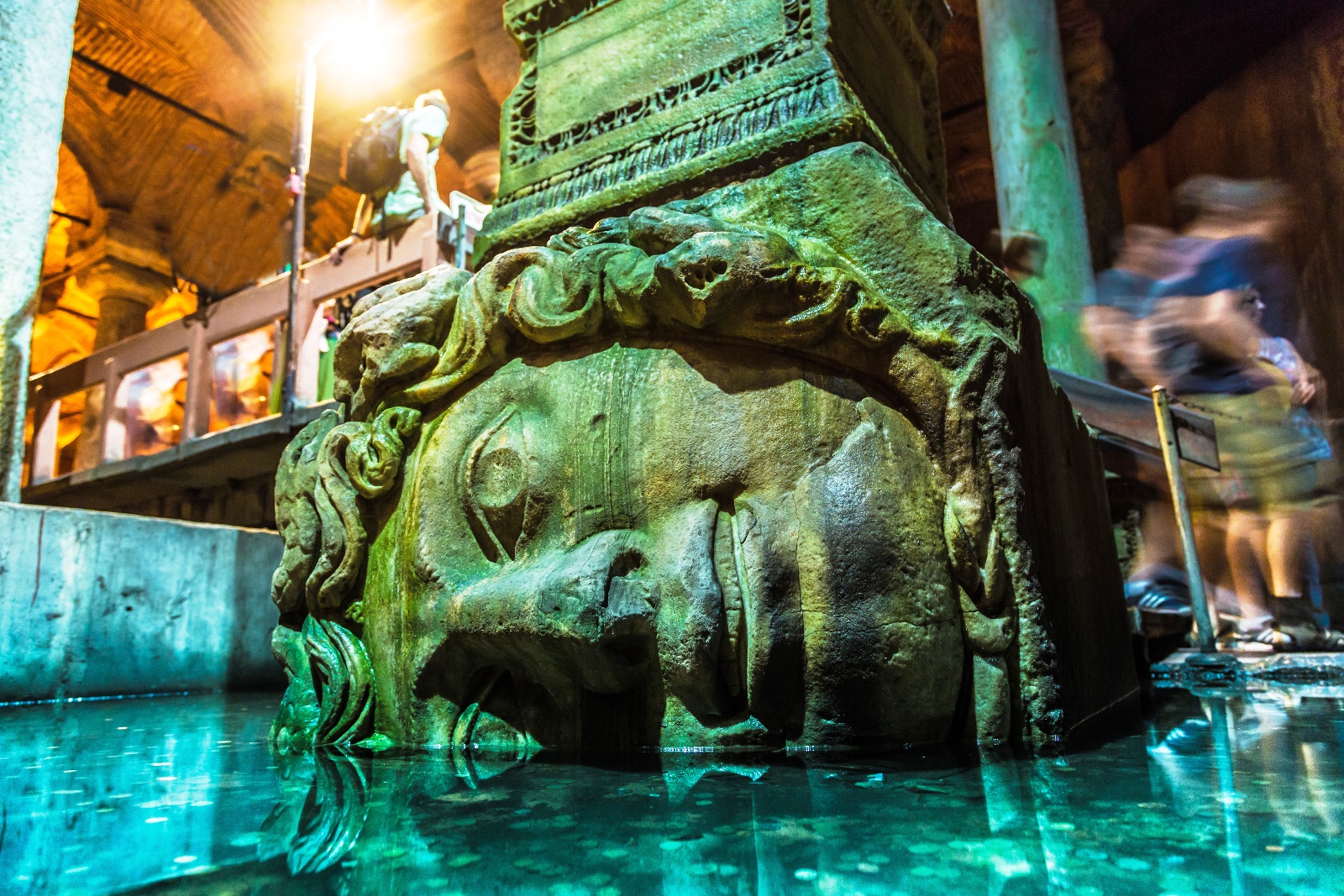You’d think visiting Hagia Sophia would be simple. It’s the most famous building in the city, everyone recommends it, and every guidebook tells you it’s a must see. But the surprising part is how many first timers walk out saying they spent half their visit trying to figure out where tourists are allowed, why some people enter free, or why the upper gallery is now the main visitor route.
According to recent updates from the Directorate of Religious Affairs, Hagia Sophia’s role as an active mosque shapes the visit more than people expect. And that’s where most guides fall short. They describe the monument, not the experience.
If you’re planning a 2026 trip, here’s the quick truth. Hagia Sophia is still breathtaking. The massive dome, the scale of the interior, the shift from Byzantine basilica to imperial mosque to modern symbol, all of it hits you the moment you enter. But the way you explore it now is different from how older blogs describe it.
Tourists visit the upper gallery, not the main prayer hall. The ticketed route focuses on mosaics, the dome, inscriptions, and sweeping balcony views. The ground floor is primarily used for worship, which creates time windows during prayers when visitors must wait outside.
According to travelers on TripAdvisor and r/Istanbul, this catches people off guard. They arrive at noon, see a crowd, hear the call to prayer, and suddenly find the visitor entrance closed. Many also misunderstand the Hagia Sophia entrance fee, expecting it to be free because older guides still circulate outdated information. That confusion shapes the mood of the day more than any architectural detail.
Think of Hagia Sophia as two spaces living side by side. A functioning mosque filled with movement and sound. And a monumental visitor gallery holding centuries of layered history. When you understand this balance, the visit becomes smoother, calmer, and far more meaningful.
7 Fascination Fast Facts About Hagia Sophia
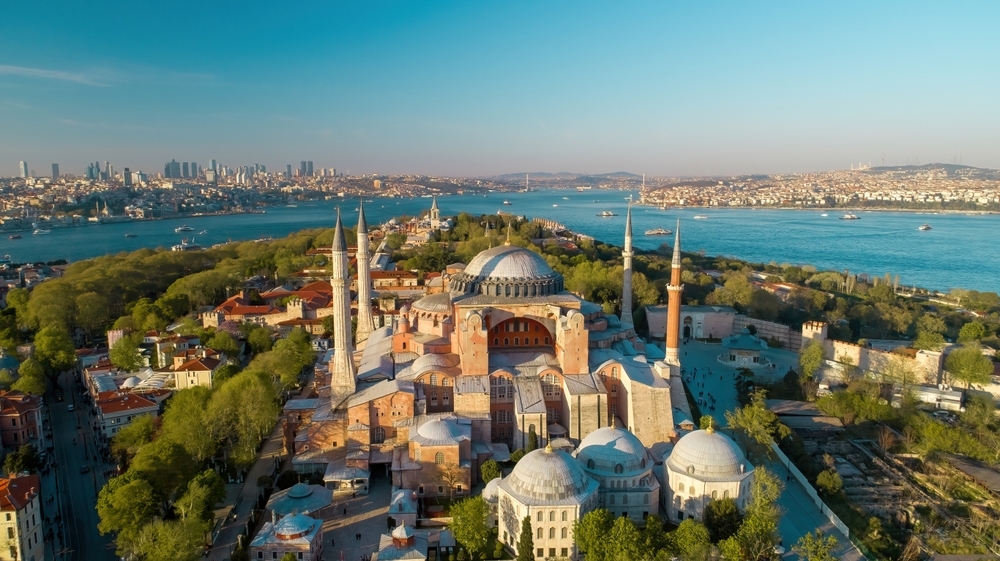
Istanbul’s, as well as the World’s one of most visited sights. So what lies behind?
- The name “Hagia Sophia” means “Holly Wisdom” in Greek.
- First built in 325 AD, collapsed 2 times and rebuilt 3 times.
- Built in the year 532 AD, as the world’s largest place of worship.
- Converted to a mosque after Ottoman Empire’s conquest of Istanbul in 1453.
- Converted to a museum in 1935.
- A decree on 10th of July 2020 to formally declare the Hagia Sophia as a mosque.
- Declared as one of the world’s greatest architectural works.
- Accepted as the 8th wonder of the world.
- Main highlights include the Christian mosaics, Islamic calligraphy roundels, Mihrab, and Viking graffiti.
No Regrets Hagia Sophia Tickets & Tours
If you are looking for the best Hagia Sophia entrance with guided tours, trust our recommendations, save time and money, we have you covered.
Skip-the-line Tickets
- Hagia Sophia Skip the line Ticket with Audio Guide and Augment Reality
- Hagia Sophia Skip-the-Line Ticket & Museum Option
- Hagia Sophia Skip-the-Line Ticket & Blue Mosque Audio Guide
- Hagia Sophia Entry Ticket with Audio Guide
Guided tours with Fast Track Tickets
- Hagia Sophia, Blue Mosque Tour & Ticket + Optional Basilica
- Blue Mosque & Hagia Sophia Guided Tour w/ Tickets
Combo Tours & Tickets
- Combo: Hagia Sophia+Basilica Cistern Optional Topkapi Palace
- Topkapi, Hagia Sophia and Basilica Cistern Tour
- Discover the Icons – Hagia Sophia, Topkapi Palace, and Basilica Cistern
- Topkapi, Hagia Sophia and Basilica Cistern Tour
Quick History
Hagia Sophia’s current building is the third construction and has different architectural style due to the rulers of the city.
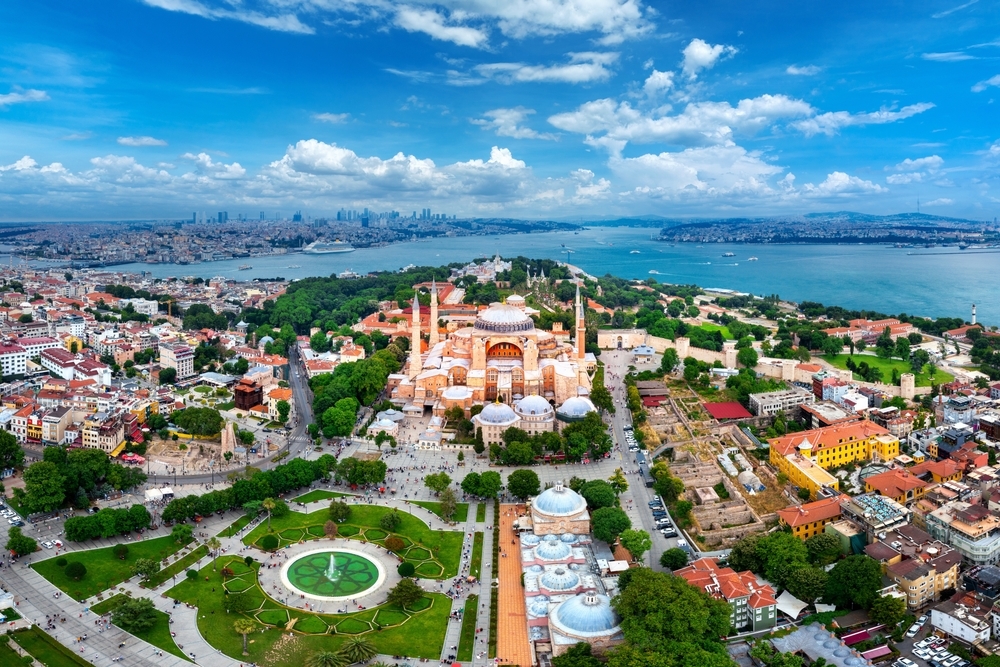
No Regrets Booking Advice
Roman & Byzantium Period
- Hagia Sophia was first constructed in 325 for the great wish and will of the Emperor Constantine to move the capital of the Roman Empire to Istanbul.
- After a big earthquake in 360, the construction restored by the Emperor Constantine and called as “the Big Church (Megale Ekklesia)”.
- Until the period of Byzantium Emperor Justinianos (527-565), the building had many damages due to rebellions and big fires and so restored again and again.
- And finally it is reconstructed in 5 years with the administration of the famous architects Anthemios (Tralles) and Isidoros (Miletus) under the order of the Emperor Justinianos.
- Hagia Sophia has been the biggest church and constructed by the East Roman Empire and was used as a church for 916 years, as well as the place in which the emperors were crowned, until the Ottoman Empire’s conquest of Istanbul in 1453, by Fatih Sultan Mehmed.
Ottoman’s Period
- After the conquest of Istanbul, Fatih Sultan Mehmed was converted the church into a mosque. Hagia Sophia than was used as a mosque for 482 years.
- During the Ottoman Empire, the sultans gave Hagia Sophia a special value. Every effort has been made to protect and sustain Hagia Sophia, the symbol of the conquest.
- Ayasofya Mosque Foundation was established by Fatih Sultan Mehmet.
- The first minaret, pulpit and altar of Hagia Sophia was built with order of Fatih Sultan Mehmed. He also added a madrasah and library to the place where the building is located.
- Sultan Beyazit II (1481-1512) added a mihrab of white marble and a minaret in the northeast corner.
- Sultan Suleiman the Magnificent (1520-1566) presented the two lamps he brought from Hungary to Hagia Sophia.
- During the period of Sultan Selim II (1566-1574), external retaining structures were added and strengthened by the famous Ottoman Architect Sinan to strengthen Hagia Sophia.
- Sinan also made the dome extremely durable by feeding the gaps between the piers carrying the dome of Hagia Sophia and the side walls with arches.
Period of the Turkish Republic
- After the establishment of the Republic of Turkey, Hagia Sophia was closed due to restoration work between 1930-1935.
- In 1935, with the order of Ataturk, the founder of the Turkish Republic, and the decision of the Council of Ministers, Hagia Sophia was converted into a museum.
- Hagia Sophia declared as UNESCO World Heritage Site in 1985.
- The part of the Hagia Sophia (named Hunkar Pavilion) was opened for prayers for the first time in October 2016, by the Presidency of Religious Affairs.
- Finally a decree on 10th of July 2020 to formally declare the Hagia Sophia as a mosque, after Turkey’s administrative court annulled a 1934-dated decision that paved the way for the use of Hagia Sophia as a museum.
- First prayer was held in Friday 24, July 2020.
How To Visit Hagia Sophia In 2026
Here’s the part most travelers wish they had read before arriving. Hagia Sophia in 2026 works differently from older guides, and the layout, rules, and pricing shape your visit more than any architectural fact. Think of this section as your quick cheat sheet before we unpack each topic in detail.

The first thing to know is that tourists enter Hagia Sophia through a new temporary gate across from the Sultan Ahmed III Fountain, next to the Imperial Gate of Topkapi Palace. This system began in early 2024 to protect visitors from ongoing restoration near the Bayezid II minaret.
According to the official visiting guidelines, this remains the main arrangement until the structural work finishes.
The tourist route leads directly to the upper gallery, not the prayer hall. A long, accessible-style ramp takes you up, where you see the main nave from above, walk through the Marble Door, view the Byzantine mosaics, and explore the Ottoman gallery rooms. The exit is through another ramp on the northeast side.
The Hagia Sophia entrance fee for tourists is €25, paid at the booth across from the fountain. Visitors under 8 enter free with ID. The fee includes an AR audio system available in 23 languages. Just scan the QR code and use your own headphones, or rent one for a small charge.
General visiting hours run from 09:00 to 19:30. The visiting area closes during prayer times and every Friday between 12:30 and 14:30. According to the Directorate of Religious Affairs, this schedule is tied to worship needs, so expect occasional short closures.
Most questions visitors ask boil down to timing, dress code, and where tourists are actually allowed. Our guide will explore through all of it.
What’s New At Hagia Sophia In 2026 (Rules, Fees, Restoration Changes)
Most of the confusion around visiting Hagia Sophia comes from outdated articles written before 2024. The way tourists enter, the parts they see, the rules they follow, and even the path through the monument have all changed.
According to the updated visitor guidelines and traveler reports on TripAdvisor and r/Istanbul, the 2026 experience looks very different from what many people expect. Here’s what actually matters for your upcoming visit.
The biggest shift is the temporary visitor gate across from the Sultan Ahmed III Fountain, next to the Imperial Gate of Topkapi Palace. This entrance was introduced in January 2024 to keep visitors safe during restoration around the Bayezid II minaret. Until that work finishes, all foreign visitors start here. The ticket booth is right beside it, so everything stays in one compact zone.
Tourists now explore Hagia Sophia through the upper gallery, accessed by a long ramp immediately after the entrance. This means the ground floor mostly functions as an active mosque for worshippers, while the balcony-level visitor route focuses on mosaics, inscriptions, and panoramic views across the main nave.
According to the Ministry of Culture and Tourism, this layout helps balance preservation with worship needs.
The Hagia Sophia ticket price for tourists is €25, adjusted to TL at the booth’s daily rate. Children under 8 enter free. ICOMOS, IPC, and press cards do not grant free entry, something older guides often misreport.
Visitors use a QR based AR system available in 23 languages, which allows quiet explanations without disrupting prayer activity.
Restoration continues through 2026, especially around the domes and minarets. You may see scaffolding, protective barriers, or altered walking paths. Anadolu Agency reports that these works focus on long term structural stability and earthquake resilience. The good news is that the upper gallery remains fully visitable during this process.
Hagia Sophia Tickets And Entrance Fee: Tourist Route vs Worship Access
This is the part that confuses travelers more than anything. Older blog posts still claim Hagia Sophia is free, some say tourists enter the prayer hall, and others insist shoes must be removed. None of that reflects how the system works in 2026. The reality is simpler once you see the structure behind it.
According to the most recent visitor guidelines and what travelers share on TripAdvisor and r/Istanbul, Hagia Sophia now operates with two completely different entrances, two different purposes, and two different sets of rules.
Do you need a ticket to enter Hagia Sophia?
If you are visiting as a sightseer, yes. The Hagia Sophia tickets for tourists cost €25, paid at the booth across from the Sultan Ahmed III Fountain. The ticket grants access to the upper gallery, where visitors can see the sanctuary from above, view the mosaics, and explore the Byzantine and Ottoman sections.
This is the official, designated visitor route. It does not include the mosque’s main prayer hall. Children under 8 enter free with ID.
Worship access: who enters free?
The prayer area remains free for worshippers. According to current mosque guidelines, Turkish Muslim worshippers enter through the main gate at Hagia Sophia Square. Foreign Muslim visitors may also enter for prayer, though they must arrive before prayer times and follow the worship flow.
This entrance is separate from the paid visitor route. The key distinction is intention. If you are entering to pray, you follow mosque rules. If you are entering to sightsee, you purchase a ticket.
Online tickets, guided tickets, and passes
You can either buy your Hagia Sophia ticket onsite or through the official online sellers like DEM Museums, Getyourguide or Viator.
Online tickets help you skip the booth line, though you still go through security. Guided tour tickets often include a host who accompanies you through the entry process before you explore independently.
No version of the Museum Pass includes Hagia Sophia, something many visitors only discover after arriving.
The AR guide is included in your ticket, and you scan a QR code for audio in 23 languages.
So, we would recommend:
- Short on time: go with skip-the-line
- If you want context: guided tour
- Visiting many sites: combo ticket or city pass
Standard Entrance Ticket
The standard Hagia Sophia ticket gives access to the upper gallery, the Byzantine mosaics, the Marble Door, and the balcony views overlooking the sanctuary. According to muze.gov.tr’s visitor information, this ticket applies strictly to the dedicated gallery entrance, not the prayer hall. It’s ideal if you prefer exploring independently.
The tradeoff is the queue. Travelers often report waiting anywhere from twenty to sixty minutes during peak hours because everyone passes through the same security flow before reaching the ramp.
Skip The Line Ticket
Skip-the-line helps you bypass the payment queue, which can grow quickly on busy mornings and cruise ship days. You still go through security, as no ticket bypasses that step, but you save time at the booth.
Many travelers on TripAdvisor call this the most practical upgrade, especially from April to October. Just keep expectations grounded. Skip-the-line means skipping the ticket queue, not skipping the security process.
Skip-the-line with Host Tickets, We Recommend:
Audio Guide or Self-Guided App Tickets
Platforms like GetYourGuide and Viator sell versions that combine entry with a guided app. Surprisingly, these are helpful because the audio fills gaps left by limited on-site signage.
It explains the layered history, structural changes, Christian and Islamic symbolism, and what restoration has altered over time. Since signal can be patchy around the entrance, downloading the app in advance makes everything smoother.
Skip-the-line with Audio Guide, We Recommend
- Hagia Sophia Skip the line Ticket with Audio Guide and Augment Reality
- Hagia Sophia Skip-the-Line Ticket & Museum Option
- Hagia Sophia Skip-the-Line Ticket & Blue Mosque Audio Guide
- Hagia Sophia Entry Ticket with Audio Guide
Guided Tour Tickets
If visiting Hagia Sophia has always been a dream and you want deeper understanding, guided entry changes the pace entirely. Guides point out details people usually miss: where earthquake reinforcement altered the dome, which mosaics were uncovered last, and why the building looks different from older photos.
Many visitors say this was the moment the monument finally “clicked”. It also simplifies the whole entry process, which helps if the square feels overwhelming.
Guided tours with Fast Track Tickets, We Recommend
- Hagia Sophia, Blue Mosque Tour & Ticket + Optional Basilica
- Blue Mosque & Hagia Sophia Guided Tour w/ Tickets
Combo Tickets With Topkapi Palace or Basilica Cistern
If your day already includes multiple major sites, combo options can keep things organized. They typically pair Hagia Sophia with Topkapi Palace or the Basilica Cistern. These combos work best if you already plan a full Old City day and prefer one booking instead of juggling separate reservations.
The only thing to factor in is timing. Hagia Sophia usually has the slowest entry flow, so it’s smart to place it at the start of the combo window.
Combo Tickets, We Recommend
- Combo: Hagia Sophia+Basilica Cistern Optional Topkapi Palace
- Topkapi, Hagia Sophia and Basilica Cistern Tour
- Discover the Icons – Hagia Sophia, Topkapi Palace, and Basilica Cistern
- Topkapi, Hagia Sophia and Basilica Cistern Tour
Passes and Digital Cards That Include Hagia Sophia
Hagia Sophia fits into Istanbul’s digital passes differently than other museums. Because it operates as an active mosque with a ticketed visitor gallery, most passes offer guided access rather than classic turnstile entry. This is often a relief for travelers because the square’s signage can be confusing, especially when prayer-time closures shift the flow.
Istanbul MegaPass
The MegaPass Istanbul includes Hagia Sophia through a guided entry slot. You meet a host at a set time and enter together. This helps if the crowds intimidate you or if you prefer someone leading the way. Many visitors appreciate having a person explain how the flow works, especially since prayer times can shift closing intervals.
Istanbul E-Pass
The Istanbul E-Pass works the same way. It includes Hagia Sophia with a guided entry window as part of its attraction system. If your itinerary includes the Basilica Cistern, Bosphorus cruise, palace museums, and a handful of tours, E-Pass becomes good value because it simplifies scheduling and bundles everything into one interface.
Passes work best for travelers who like structure. Independent visitors often find a simple gallery ticket easier. Knowing which camp you’re in helps you pick the right option immediately.
Where to Buy Tickets Online Safely
Trusted platforms like GetYourGuide or Viator are the most reliable places to book Hagia Sophia tickets. They clearly show the operator, offer flexible cancellation (often up to 24 hours before your visit) and include helpful extras like audio guides, AR experiences or a guided introduction.
We recommend these the most because they minimize surprises. Everything you need is in the confirmation email, and the meeting points are clearly marked. Local operators partnered with these platforms also tend to communicate better than independent sellers.
Just avoid buying tickets from random blogs or unclear third party sites. Many of them look official but give incomplete instructions, and that’s where travelers run into problems.
We Recommend the below options
What “Skip the Line” Really Means at Hagia Sophia
This is an important point. Skip the line at Hagia Sophia means skipping the payment queue, not bypassing security. Security screening is mandatory for everyone. Reviews across platforms like Headout and TripAdvisor mention this often.
So yes, you save time by avoiding the ticket kiosk or on site purchase line. And yes, your entry becomes smoother because you know exactly where to go. But don’t expect to walk straight into the building without pausing at security. No one gets that.
Buying on the Day at the Ticket Window
This is possible, and it works fine if you visit very early or during low season. But once the lines build up, buying on site means two waits: one to pay, one for security. In busy months, that can easily add 20 to 45 minutes. If you prefer a calm start to your visit, buying online is simply the safer choice.
Common Scams and Mistakes Near the Gates
Around Sultanahmet Square, some people approach visitors offering “special access”, “VIP entry” or “secret shortcuts”. None of these exist. Hagia Sophia has a strict entrance system, and the only legitimate tickets come from official channels or reputable platforms.
A simple rule: If someone approaches you at the gate trying to sell you anything, just walk away.
Booking online through GetYourGuide or Viator avoids all of this, gives you clear instructions and ensures you’re dealing with known operators. It’s the easiest way to start your visit smoothly and confidently.
Hagia Sophia Visiting Hours, Prayer Times And Best Time To Go
If there’s one thing that shapes the Hagia Sophia experience more than the ticket type, it’s timing. According to the Directorate of Religious Affairs and countless traveler reports on TripAdvisor, the building follows a rhythm based on prayer, security flow, and crowd surges. Understanding these patterns turns a potentially stressful visit into a calm one.
Visiting hours
The official visiting area is expected to operate daily from 09:00 to 19:30. This applies to the upper gallery, which is the dedicated tourist route. The prayer hall opens only to worshippers and follows a separate schedule. While the core hours sound straightforward, the real story is how prayer times interrupt this window.
When Hagia Sophia closes to tourists?
Hagia Sophia is an active mosque. That means tourists must exit during prayer times. The closures are short during the five daily prayers, but the midday period is the one that catches most visitors off guard.
According to Diyanet’s prayer listings, the most significant weekly closure is Friday, when the visitor area shuts between 12:30 and 14:30 for the noon prayer. This window is strict, and travelers who arrive during that time remain outside until reopening.
Prayer time closures are the number one reason people say they “waited for nothing.” The schedule shifts slightly through the year, so checking daily prayer times for Istanbul helps prevent surprises.
Best time of day to visit
Early morning remains the sweet spot. Visitors entering between 09:00 and 10:00 often report the smoothest flow, the shortest lines at the security checkpoint, and quieter upper gallery spaces.
Late afternoon also feels good because tour groups thin out and the sun hits the interior differently through the gallery windows, creating a softer atmosphere. Midday tends to be the least comfortable due to heat in the square, longer queues, and prayer-related interruptions.
A little timing awareness goes a long way here. When you align your visit with the building’s rhythm, Hagia Sophia feels less frantic and far more majestic.
Dress Code, Shoes, Photography And Etiquette Inside Hagia Sophia
Hagia Sophia feels different the moment you step near the entrance. It’s busy, layered, sacred, and deeply atmospheric in a way most historic sites aren’t. Since you’re entering a functioning mosque, the experience blends reverence with sightseeing.
According to the updated guidelines shared by the visiting authority and what travelers mention on r/Istanbul, the expectations are clear once you know them, but they’re easy to miss if you rely on older blogs.
What to wear inside Hagia Sophia?
There’s no complicated rulebook, just modesty. Shoulders and knees should be covered for everyone. Women need a head covering before they enter the building. Staff won’t pressure you, but they will ask you to follow mosque etiquette.
If you forget your scarf or clothing isn’t suitable, you can buy a simple headscarf for about one euro or a body cover for a small fee at the ticket booth.
This is mentioned often in TripAdvisor reviews because the booth is directly beside the visitor entrance, which makes it quick to sort out.
Shoes and walking inside the building
This is where things get confusing because old guides still say you must remove your shoes. For the upper gallery visitor route, you keep your shoes on. The carpets and shoe removal areas are for the prayer hall only.
According to the updated visitor instructions, the ramps and gallery floors are not part of the prayer zone, so shoes stay on throughout the visit. Just be ready for a lot of standing and slow walking, especially when the gallery fills up.
Photography and respectful behavior
Photography is allowed, but keep the flash off. Avoid photographing worshippers in the prayer hall from above. The building amplifies sound, so lowering your voice changes the entire feel of the space.
Staff members will gently remind groups to move aside when they block gallery transitions. As one traveler on TripAdvisor put it, “The mood is beautiful if everyone remembers they’re inside a mosque first and a landmark second”.
The Layout: Ground Floor For Worship, Upper Gallery For Visitors
Most first-time visitors imagine wandering the entire building the way older guidebooks describe. But since 2020, and especially after the changes implemented in early 2024, Hagia Sophia works differently.
According to the updated guidelines shared in the official visiting announcement, tourists follow a dedicated, structured path that protects worship space, preserves historic floors and makes crowd flow manageable. Knowing this before you arrive prevents that confused moment at the entrance when people realize they’re not going into the main prayer hall.
What tourists actually see
The visitor route begins at the temporary entrance beside the Sultan Ahmed III Fountain. After ticket control and security, you walk up a long inclined ramp. This leads straight to the upper gallery, which is the heart of the experience.
From here, you look down into the sanctuary, see the scale of the dome, and trace the fusion of Byzantine and Ottoman elements from a vantage point that photographers often call the most dramatic angle in the building.
The upper gallery includes highlights like the Marble Door, the Deesis mosaic, and the intricate imperial loge. According to visitors on TripAdvisor, this level gives you the kind of continuity older blog posts talk about, even though the route has changed.
The balcony offers uninterrupted views across the nave, and because the prayer hall remains active, seeing worshippers below adds a sense of living context to the monument.
Why tourists no longer access the ground floor
The ground floor is reserved primarily for prayer. Foreign and local Muslim worshippers may enter the prayer hall for salah through the main gate at Hagia Sophia Square. According to the Directorate of Religious Affairs, this separation helps maintain respectful worship space while still allowing millions of visitors each year.
For most travelers, the upper gallery ends up being the highlight anyway. The mosaics are closer. The structure feels clearer. And the elevated perspective turns the vast interior into something you can actually read with your eyes instead of feeling overwhelmed by it.
Time-Boxed Routes Inside Hagia Sophia: 30, 60 And 90 Minute Plans
One reason visitors feel overwhelmed inside Hagia Sophia is the simple fact that there’s no obvious path once you enter the upper gallery. People drift, stop at the wrong points, or crowd around the first mosaic they see.
According to traveler notes on TripAdvisor and r/Istanbul, this is why some visitors say they “didn’t know what they were looking at” even though they loved the space. A clear plan fixes that. Here are three realistic routes based on how long you have and how deep you want to go.
30-Minute Essential Route
If you’re short on time, this route gives you the core experience without rushing. After the ramp brings you into the upper gallery, pause at the balcony rail directly overlooking the sanctuary. This angle frames the dome, mihrab and calligraphy medallions all at once.
Move along the right side toward the Marble Door and spend a moment with the Deesis mosaic, which is one of the clearest Byzantine pieces still visible. According to visitors who only had a quick stop between tours, this simple loop still captures the intensity of the space.
60-Minute Standard Visit
Most travelers fall into this window. Start like the essential route, but continue deeper through the gallery, stopping at the imperial loge, the cross-vaulted passages and the mosaic fragments along the inner walls. The main point is pacing. Give yourself a few slow moments at the balcony sections because the light shifts constantly.
Many people on TripAdvisor mention that the contrast between shadowed corners and sunlit domes changes what you notice. Finish by taking the full gallery loop before exiting down the northeast ramp.
90-Minute History-Lover Route
If you want to absorb everything, this is the sweet spot. Follow the full gallery path, but add more time at the Deesis, examine the geometric marble patterns under your feet, and watch how the Ottoman calligraphy panels interact visually with the Christian iconography.
According to frequent visitors, this longer route helps you read the building as a layered story instead of a quick highlight reel. You leave understanding not just what Hagia Sophia looks like, but how it evolved.
What to See Outside Hagia Sophia
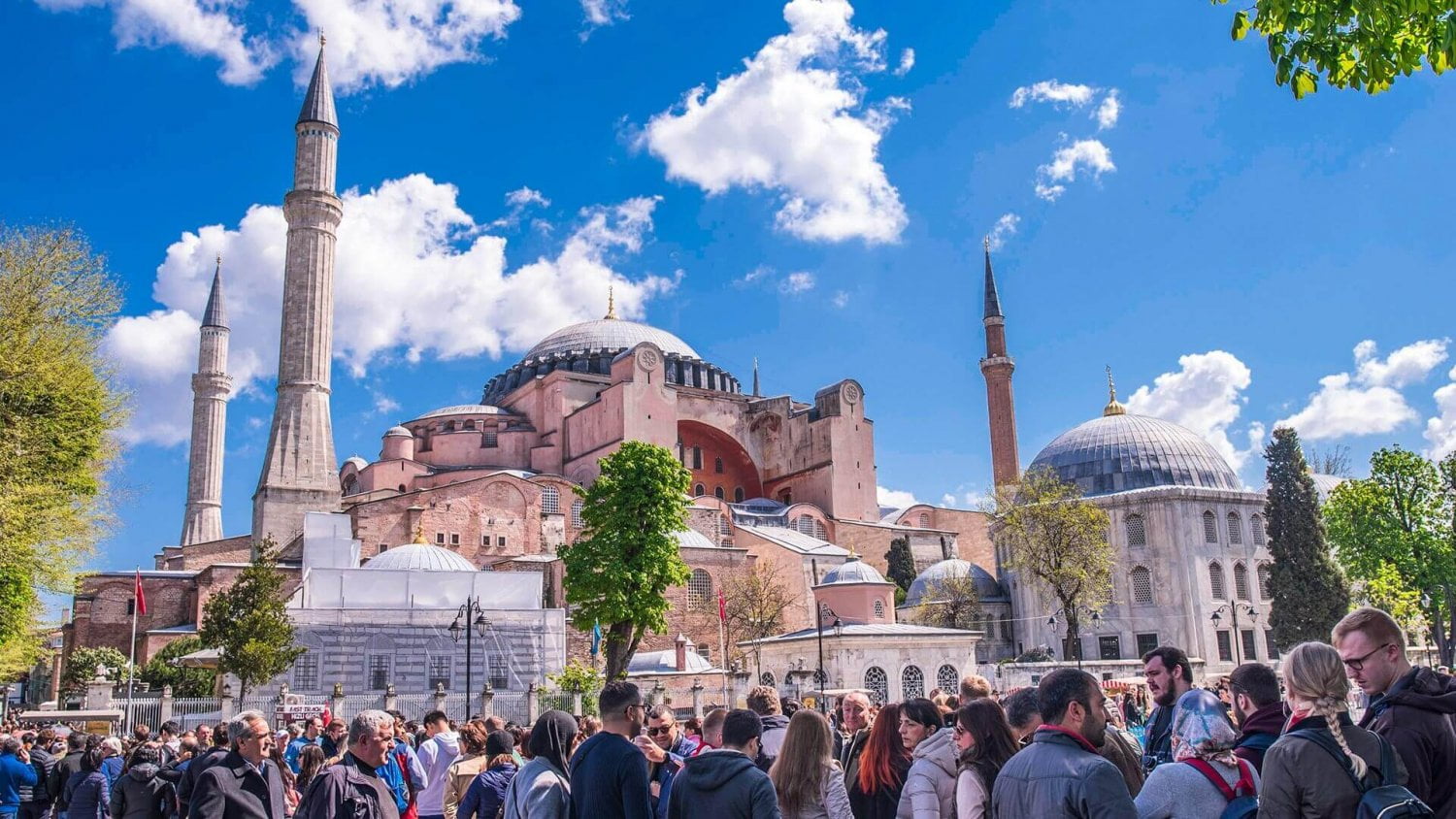
You’ll see Sultan Tombs, Elementary School, Fountain, Timing Room, Public Fountains, Minarets, Buttresses, Treasury Building (Skevophylakion), Almshouse.
Dominant Domes
The central dome, rising 55.6 meters high with a diameter of 31.87 meters, is a marvel of Byzantine architecture. Surrounded by smaller semi-domes and buttressed by massive arches, it creates an imposing sight.
Minarets
The Hagia Sophia is flanked by four minarets, each soaring into the sky. They were added during the Ottoman period and greatly contribute to the majestic silhouette of the structure.
Courtyards and Gardens
The exterior also includes beautifully maintained courtyards and gardens that allow for a moment of tranquility amidst the hustle and bustle of Istanbul.
What To See Inside Hagia Sophia (Without Getting Lost)
Even with a clear route in mind, Hagia Sophia can feel overwhelming when you’re standing inside it. The space is enormous, the history is layered, and the visual details change depending on where the light falls.
According to travelers on TripAdvisor, the biggest challenge isn’t finding the mosaics or the dome. It’s knowing what to focus on so the building doesn’t feel like a blur of stone and gold. Here’s a simple guide to the essential features you’ll see along the upper gallery path in 2026.
Current inner look as a Mosque
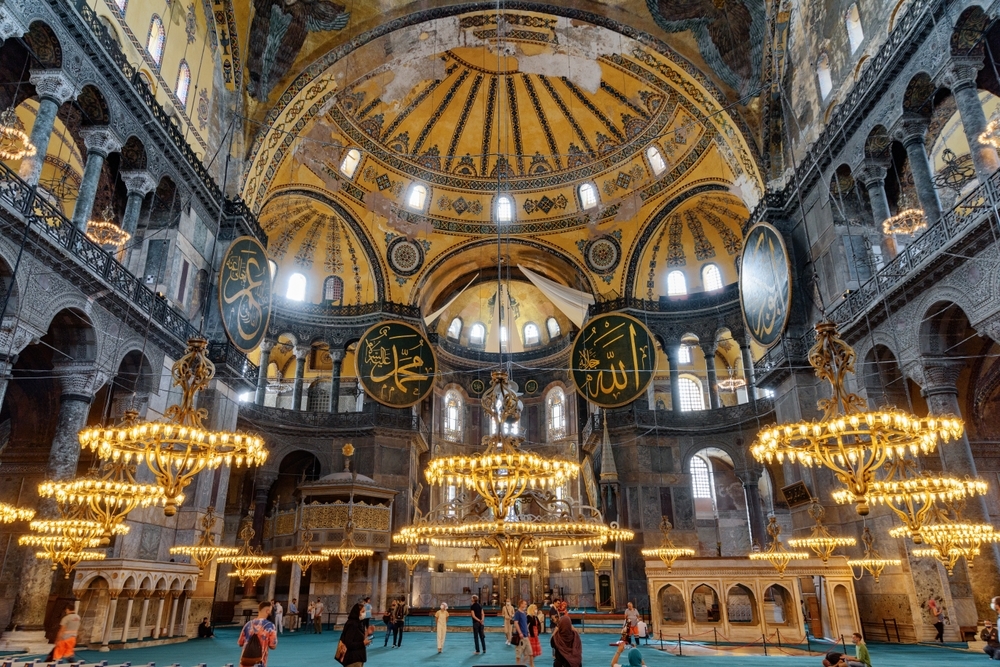
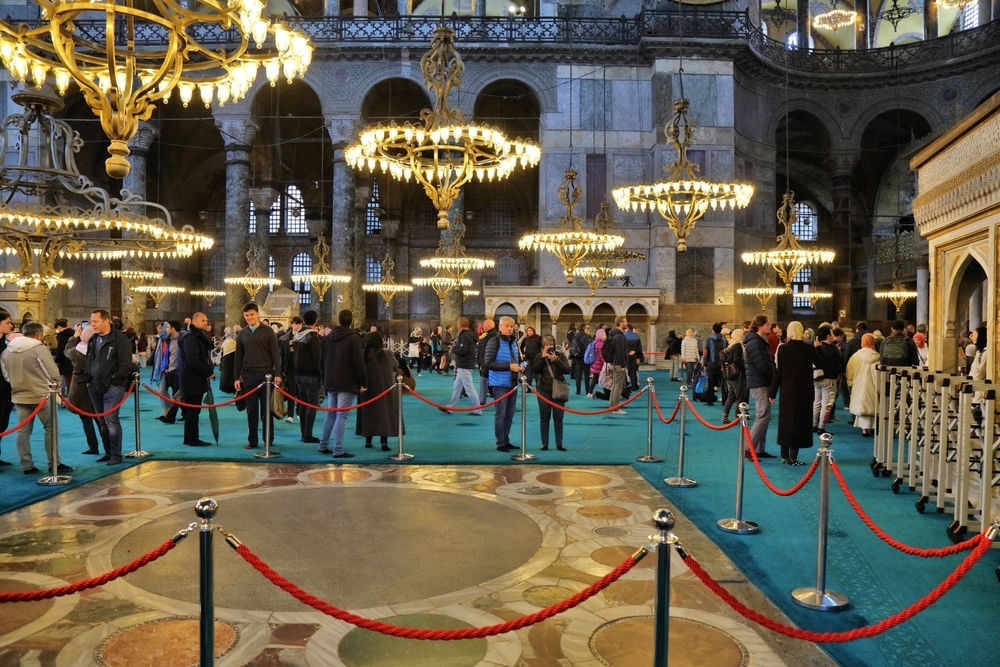
While serving as a Museum before
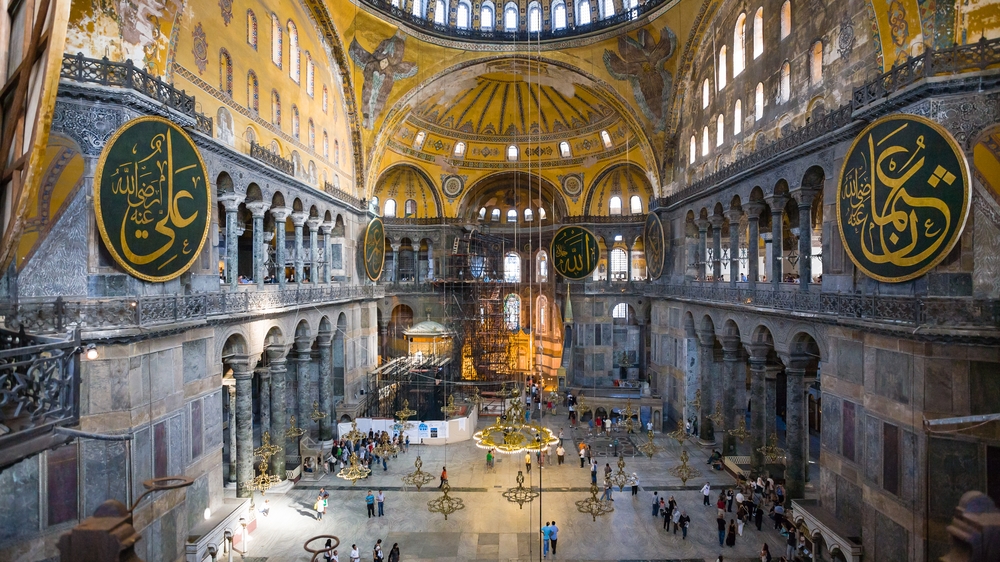
The Dome and the Light
The dome is the first thing that steals your attention. From the upper gallery, you see how it floats above the prayer hall like a giant disc of gold. Late afternoon sunlight often hits the interior through angled windows, giving the dome a soft glow that feels almost weightless.
According to visitors who came during sunset hours, this is the moment that stays in memory long after leaving.
Byzantine Mosaics
The upper gallery brings you closer to the mosaics than the old ground floor route ever did. The Deesis mosaic sits behind protective glass and remains one of the strongest artistic expressions of the late Byzantine world.

Other surviving mosaic fragments line the gallery walls, revealing how earlier layers were once hidden beneath Ottoman plaster. Travelers frequently say this section gives a sense of the building’s dual identity more clearly than any description.
Another highlight is the Empress Zoe Mosaic, which shows Christ seated between Empress Zoe and her third husband. These mosaics offer a glimpse into Byzantine religious art, making them must-see elements of any visit.
The Marble Door and Imperial Loge
The Marble Door, also known as the Heaven and Hell gate, sits quietly along the gallery corridor. Its intricate panels mark a symbolic passage between different parts of the ancient basilica. A short walk away, the imperial loge offers a window into Ottoman-era rituals. The view from here feels more intimate, giving you a sense of how rulers once experienced the building.
The View Into the Sanctuary
This might be the highlight. Much of Hagia Sophia’s emotional power comes from looking down into the prayer hall. The contrast between the geometric marble floor, the mihrab positioned toward Mecca and the bold calligraphy panels creates a layered visual story. Even with restoration scaffolding occasionally present, the sense of scale remains extraordinary.
Visiting Hagia Sophia With Kids, Older Travelers And Accessibility Needs
Hagia Sophia is unforgettable, but the visit has its physical challenges. According to families and older travelers on TripAdvisor, the mix of ramps, tight gallery corners and long standing periods catches people off guard.
Visiting With Kids
Families often love the upper gallery because it feels like a secret walkway above an ancient world. Kids enjoy peeking through the railings and spotting details on the floor below. The challenge is movement.
Strollers are allowed through the visitor route, but because of preservation rules, the visiting authority recommends folding and carrying them on the ramps and gallery sections. The incline can get tiring for younger children, especially in hot months, so small breaks near the windows usually help reset the mood.
For Older Travelers
Hagia Sophia is doable for most older visitors, but the pace should be slower. The entrance ramp is long, and the upper gallery floor has uneven spots that require attention. According to travelers in their sixties and seventies on Rick Steves’ forum, the biggest strain isn’t the walking distance but the standing time.
The gallery can get crowded between late morning and mid afternoon, which means fewer chances to lean or rest. Arriving earlier in the day gives older visitors a calmer environment and easier movement between gallery sections.
Accessibility And Mobility Considerations
Despite efforts to improve access, the upper gallery is not suitable for visitors with wheelchairs or significant mobility challenges. This is stated clearly in the updated visiting rules. The ramps and stairs along the visitor path aren’t built for wheelchair access, and the narrow gallery transitions make navigation difficult.
Visitors with mobility needs are instructed to use the Turkish Citizen Entrance with their tickets, since the ground floor is reserved for prayer but allows more accessible movement.
Each group experiences Hagia Sophia differently, but thoughtful planning smooths out the challenges. When you match your pace to your needs, the building opens up instead of wearing you down.
Guided Tour vs Self-Guided Visit
Deciding how to explore Hagia Sophia isn’t just a matter of preference. It shapes the entire rhythm of your visit.
According to travelers on TripAdvisor and r/Istanbul, the difference between a meaningful experience and a confusing one often comes down to whether someone is walking you through the layers or you’re trying to decode them alone. Both approaches work. They simply serve different types of travelers.
When a Guided Tour Makes Sense
A guided visit helps if Hagia Sophia has been on your list for years or if you’re someone who likes understanding what you’re looking at instead of guessing. Guides explain why the dome looks the way it does, how the Deesis mosaic survived, where restorations happened and what changed when the basilica became a mosque. This context gives structure to a building that can otherwise feel overwhelming.
Another practical benefit is entry flow. With a guided ticket, a host guides you through the initial steps at the temporary entrance. Many travelers say this removed the confusion of arriving between prayer-time closures, especially on crowded afternoons.
Guided visits also help during summer and cruise season when group coordination takes some pressure off navigating the space alone.
Guided tours with Fast Track Tickets, We Recommend:
- Hagia Sophia, Blue Mosque Tour & Ticket + Optional Basilica
- Blue Mosque & Hagia Sophia Guided Tour w/ Tickets
When a Self-Guided Visit Works Better
If you enjoy setting your own pace, stopping where you feel drawn or taking time to photograph details, self-guided is the better fit. The AR system included with your Hagia Sophia ticket provides audio in multiple languages, and while it isn’t as rich as a live guide, it’s more helpful than people expect.
According to visitors who used the system in 2024 and 2025, the explanations are short enough to keep you focused without slowing you down.
Self-guided visits feel best early in the morning or late in the day when the upper gallery has more breathing room. You can linger at the balcony rails, study mosaics up close or take the gallery loop slowly without being pulled along by a group.
Skip-the-line with Audio Guide, We Recommend:
- Hagia Sophia Skip the line Ticket with Audio Guide and Augment Reality
- Hagia Sophia Skip-the-Line Ticket & Museum Option
- Hagia Sophia Skip-the-Line Ticket & Blue Mosque Audio Guide
- Hagia Sophia Entry Ticket with Audio Guide
The real decision comes down to whether you want structure or freedom. Hagia Sophia rewards both, as long as your choice fits the way you like to explore.
Hagia Sophia Safety, Restoration And Mosaics Protection
The restoration work inside and around Hagia Sophia is one of the most misunderstood parts of the 2026 visitor experience. Travelers see scaffolding, closed-off corners or protective barriers and assume something is wrong. In reality, the work is part of a long-term effort to strengthen the building, protect its mosaics and ensure the structure can withstand Istanbul’s seismic activity.
According to recent updates shared through Anadolu Agency, the restoration focuses heavily on dome reinforcement and minaret protection.
Why Restoration Is Ongoing
Hagia Sophia carries fifteen centuries of architectural evolution, and each era left its own stress on the building. Engineers have been reinforcing the dome’s supporting systems, replacing aging lead coverings and improving how the structure handles seasonal moisture.
Visitors sometimes notice scaffolding near the north and northeast sections, especially around the Bayezid II minaret. This work is designed to prevent long-term erosion and improve earthquake resilience, not to limit the visitor experience.
How Restoration Affects Your Visit
The visitor gallery remains fully open. According to the official visitor guidelines, the upper gallery is structurally stable and safe during the restoration process.
You might see workers, discreet barriers or temporary coverings, but the major highlights like the Deesis mosaic, the imperial loge and the balcony views into the nave stay accessible. Most travelers report that once they’re inside and focusing on the space, the restoration fades into the background.
Protecting the Mosaics
The mosaics are particularly sensitive. Light, humidity and visitor proximity all play a role in how well they survive. Protective glass and controlled lighting now cover several mosaic panels to limit damage.
The upper gallery is ideal for this because it lets visitors see the mosaics without exposing them to the foot traffic that a ground-floor layout would bring. Conservation teams work continuously, and according to cultural heritage reports, the new measures have noticeably slowed deterioration.
So we can say that restoration is part of Hagia Sophia’s ongoing life. Rather than interrupting the visit, it preserves the parts you’re coming to see.
How To Get To Hagia Sophia From Popular Areas
Reaching Hagia Sophia is straightforward once you understand how the Old City moves. The challenge isn’t the distance but the flow of people, prayer-time closures, and the way the square changes hour by hour.
According to travelers on TripAdvisor and r/Travel, the mistake many visitors make is assuming Google Maps timing reflects reality. It usually doesn’t, especially during peak hours. Here’s how to get there smoothly from the places most travelers stay.
From Sultanahmet, Sirkeci and Eminönü
If you’re already in the historical core, you’re minutes away. From Sultanahmet Square, simply walk past the fountains and head toward the Sultan Ahmed III Fountain, which sits between Hagia Sophia and the Imperial Gate of Topkapi Palace.
The temporary visitor entrance for Hagia Sophia is directly beside the fountain. From Sirkeci or Eminönü, follow the tram line uphill toward Sultanahmet. It’s a gentle climb, and most travelers describe it as one of the most atmospheric walks in the city.
From Taksim, Galata and Karaköy
The smoothest option is the funicular from Taksim Square to Kabataş, then tram T1 to Sultanahmet. According to Metro Istanbul route updates, this is the most reliable connection because it avoids traffic entirely.
If you’re staying near Galata Tower or Karaköy, you can walk to the tram in about ten minutes and ride directly to Sultanahmet. Expect crowds during late mornings since this is a popular commuter and tourist line.
From Galataport Cruise Terminal
Cruise passengers from Galataport often underestimate how close they are. Walk or take a short taxi ride to Karaköy or Kabataş, then switch to tram T1. Travel time is roughly fifteen to twenty minutes, depending on your arrival window. This is the route local guides recommend because it avoids the longer taxi queue directly at the port.
From Istanbul Airport or Sabiha Gökçen
From Istanbul Airport, take the M11 metro to Gayrettepe, switch to M2, then continue to Vezneciler or Yenikapı, where you can transfer to the tram. It’s longer but predictable.
From Sabiha Gökçen Airport, buses to Kadıköy followed by Marmaray to Sirkeci bring you closest to Sultanahmet. Taxis are easier with luggage, but traffic near the Old City walls can get slow during rush hours.
Our Best Visiting Hagia Sophia Tips
- Muslims and non-Muslims are all allowed to enter Hagia Sophia.
- For visitors, a ticket booth has been placed near the III. Ahmet Fountain, along with an entrance point near it.
- You are kindly requested to show respect to daily five prayers (check prayer times from here) in the mosque, not to make so much noise, not to run and stand in front of the people praying.
- Some parts of the mosque used by prayers are temporarily closed to the visitors on Friday worship at noon, as not to disturb.
- Women should wear a head covering when entering to Hagia Sophia. You are able to find head scarves at the entrance free of charge.
- Taking photos are allowed, however you should not take the photos of the people praying.
- Plan at least 60 minutes for the visit. However, 90 minutes much better.
- Plan your day together with Topkapi Palace and Basilica Cistern as they are within walking distance from Hagia Sophia.
- Visit during the daylight, better in the morning, as natural light inside will make you admire the interior much better.
- Keep an eye out for unofficial guides (guides should have official badge on).
- Don’t pay attention, look in the eyes, and talk with beggars, in addition, people coming beside and ask for helping with guidance around or for money.
- Avoid weekends & Friday prayer at noon if possible, as it will be more crowded with the locals.
- Check the weather forecast and plan your day for the sunniest one if possible.
Hagia Sophia In Your Istanbul Itinerary
Hagia Sophia sits at the center of Istanbul’s historical core, which makes it easy to pair with other landmarks. The challenge isn’t distance but timing.
According to travelers on TripAdvisor and r/Travel, the biggest mistake first timers make is placing Hagia Sophia at the wrong point in their day and getting caught in prayer closures or long security lines. Here’s how to position it so the visit flows naturally instead of feeling chaotic.
One Day in the Old City
If you only have a single day in Sultanahmet, start with Hagia Sophia right after opening. The square is calmer, the visitor route moves faster and the light in the upper gallery feels clean and quiet.
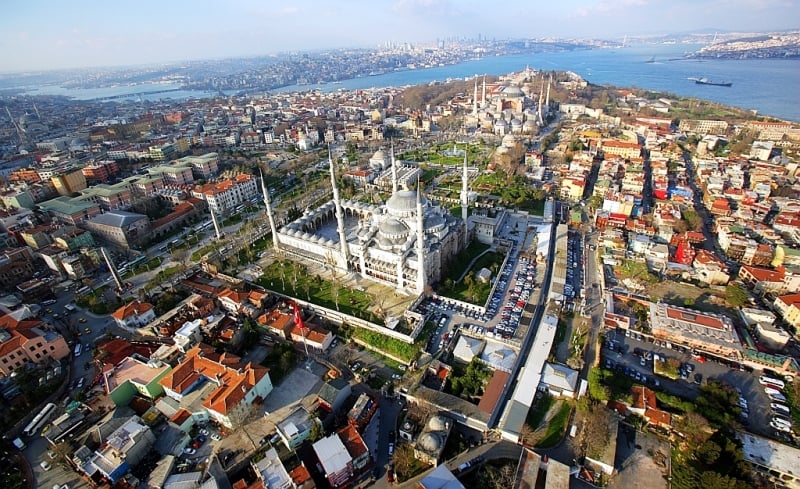
Afterward, walk directly to the Blue Mosque, which sits just across the square. Lunch near Sultanahmet Square keeps you central, and the afternoon is perfect for heading underground into the Basilica Cistern, where the cool air gives you a break from the crowds. Many travelers say this order creates a steady pace that never feels rushed.
Two Day Old City Plan
Place Hagia Sophia at the beginning of day one. It anchors the rest of your trip and clears up the prayer-time uncertainty immediately. Visit Topkapi Palace later the same morning or early afternoon. The two sites sit only a few steps apart, and the Imperial Gate is near the Hagia Sophia visitor entrance.
Save the Grand Bazaar, Spice Bazaar or Gülhane Park for day two. According to visitors who split the itinerary this way, everything feels more relaxed because the intense landmarks aren’t stacked back to back.
Three Day Plan
With an extra day, Hagia Sophia can take on a more spacious role. Visit in the early afternoon when the square settles between waves of tour groups. Pair it with the Archaeology Museums, a slow walk through Sultanahmet’s backstreets or tea at a rooftop with a view of the dome.
The added time lets you enjoy the building without rushing to the next stop. The Istanbeautiful team often recommends this approach for travelers who want history but also want moments of softness in their day.
When Hagia Sophia sits in the right place in your itinerary, the rest of your Old City experience feels smoother from start to finish.
The Hagia Sophia Experience Museum
The newly opened Hagia Sophia Experience Museum is also worth a visit. It takes you on a journey through time, culture, art, and science.
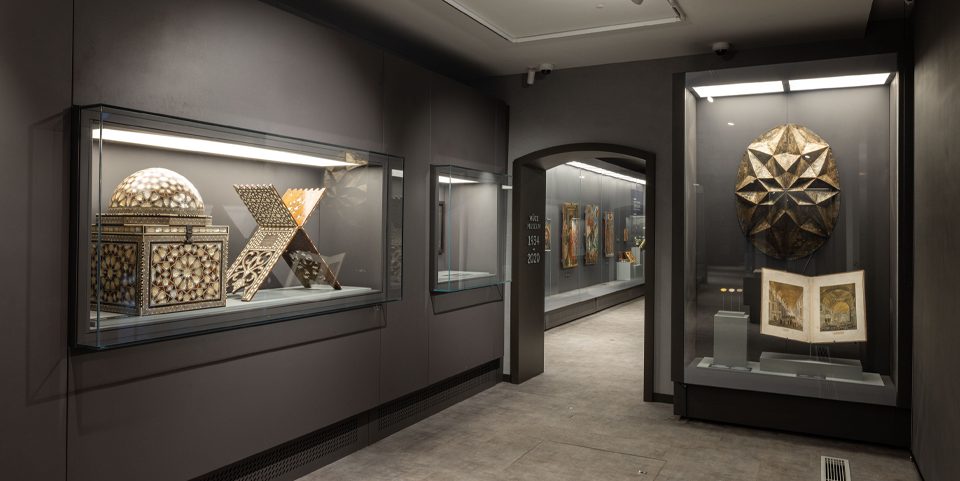
This museum is right in the middle of Sultanahmet Square, close to the Museum of Turkish and Islamic Arts and only a short walk from the famous Hagia Sophia. It promises tourists a captivating experience that will immerse them in the beauty of one of the world’s oldest sanctuaries.
Most visitors say it completely changes the way they understand Hagia Sophia when they see it afterward. It gives context to what you’re looking at inside the gallery: why certain mosaics survived, how the structure evolved and what the building symbolized across empires. For travelers who want to understand the “why” behind the architecture, it’s a meaningful add-on.
You can visit the museum independently or through the Hagia Sophia History Digital Experience Museum Ticket (directly from the Museum).
If you enjoy storytelling, visual history or simply want a deeper emotional connection before stepping into the mosque, this experience is genuinely worth considering.
Nearby Attractions to Explore
Stepping out of Hagia Sophia Istanbul, you’re already surrounded by some of the most meaningful places in the historic peninsula. According to traveler discussions on TripAdvisor and Reddit, most first time visitors underestimate how close everything is.
You can walk from one landmark to the next in just a few minutes, which makes Hagia Sophia the perfect anchor point for a full Sultanahmet day. Here’s what pairs naturally with your visit.
Blue Mosque
Just across the square, the Blue Mosque balances Hagia Sophia beautifully. One feels monumental and layered, the other airy and calm. Visitors often say that seeing Hagia Sophia first makes them appreciate the Blue Mosque’s symmetry more. It’s free to enter, though prayer times pause tourist entry, so plan around midday Fridays in particular.
Basilica Cistern
Only a short walk away, the Basilica Cistern offers the complete opposite atmosphere. After Hagia Sophia’s height and brightness, stepping into the dim, reflective chamber feels like entering another world. Many travelers prefer doing Hagia Sophia first, then cooling down in the cistern’s quiet walkway. The Medusa heads, the shifting lights and the stillness create a strong contrast that stays with you.
Hippodrome of Constantinople
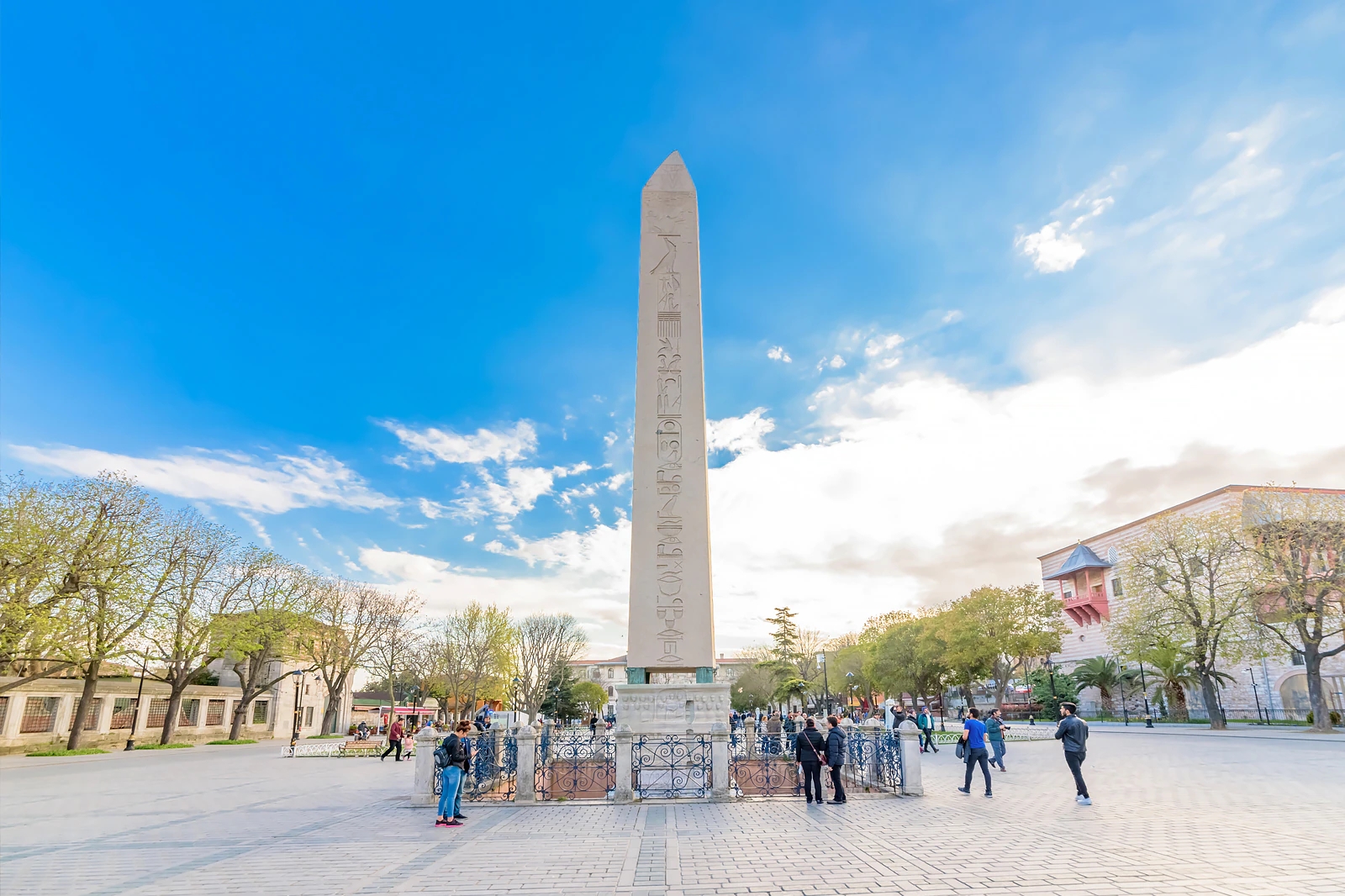
Just beyond the Blue Mosque, the Hippodrome is ideal when you want a breather before your next stop. It’s open air and easy to walk. The Obelisk of Theodosius, the Serpent Column and the German Fountain help you mentally connect the layers of Byzantine and Ottoman history you just saw inside Hagia Sophia.
Topkapi Palace
A few minutes uphill, Topkapi Palace fits perfectly either before or after Hagia Sophia. If you’re already in a reflective mood from the mosaics and gallery walk, the palace’s courtyards and Harem rooms continue the story of imperial Istanbul. Many visitors prefer doing Hagia Sophia first, then spending a slower, longer stretch at the palace.
Sultanahmet Square Cafes
Right outside, small cafes make it easy to reset between attractions. Travelers often mention that a short tea break here helps them avoid mosque fatigue, especially on hot days. The square is one of the best people watching spots in the Old City.
Everything is close, everything is walkable, and when planned in the right order, your day flows with almost no friction.
Common Traveler Questions About Visiting Hagia Sophia
How much is the Hagia Sophia entrance fee in 2026?
The foreign visitor ticket remains 25 euro, paid at the booth beside the Sultan Ahmed III Fountain or through the official online platform. The exchange rate displayed at the booth determines the TL amount for that day.
Can you visit Hagia Sophia for free?
Only children under 8 enter free, with a valid ID. There is no free general visiting hour for adults. Praying Muslims may enter the prayer hall through the main gate without charge, but this is separate from the visitor gallery.
Do you need to cover your head or remove your shoes?
For the visitor gallery, you keep your shoes on. Women should wear a head covering when entering the mosque grounds. Scarves are available at the booth for a small fee. Men do not need head coverings.
Does the Museum Pass include Hagia Sophia?
No. Hagia Sophia’s gallery is not part of the Museum Pass system. You must purchase a separate ticket.
What are the opening hours in 2026?
Hagia Sophia is open daily from 09:00 to 19:30. The visiting area closes between 12:30 and 14:30 on Fridays for prayer.
Can you visit during prayer times?
The visitor gallery may stay open during standard prayer times except Friday midday. The ground floor prayer hall is always reserved for worship.
Is Hagia Sophia wheelchair accessible?
The current visitor route to the upper gallery is not suitable for wheelchairs or significant mobility limitations. Visitors with mobility needs should use the Turkish Citizen Entrance to access the ground level.
How long does a visit take?
Most people spend 30 to 60 minutes. History lovers often stay 90 minutes.
Is photography allowed?
Yes, photography is permitted in the visitor gallery. Please avoid pointing your camera toward worshippers in the prayer area below.
Can you enter with a stroller?
Yes, but strollers must be folded and carried on ramps and gallery floors to protect the historic surfaces.
Statistics and Trends About Visiting Hagia Sophia
- Hagia Sophia receives an estimated 17–20 thousand visitors per day in peak season, according to Istanbul tourism figures and on-site reports from 2024.
- The upper gallery now receives roughly 65 percent of all sightseeing traffic, since the prayer hall is reserved for worship. This shift began after the 2024 visitor route change.
- Security lines can stretch from 15 to 45 minutes on busy days, with the longest waits between 10:30 and 13:00, based on traveler reports across TripAdvisor and r/Istanbul.
- Friday noon closure (12:30–14:30) impacts nearly 30 percent of visitors, because many tourists unknowingly arrive during that window.
- More than 50 percent of first time visitors say they were surprised that tourists no longer visit the ground floor, a common comment in 2024–2025 reviews.
- Around 70 percent of foreign travelers now purchase their Hagia Sophia ticket online, driven by reduced waiting times at the temporary entrance.
- Restoration work on the domes and minarets is projected to continue into 2026, with sections of scaffolding visible in approximately 20 to 30 percent of the interior at any given time.
- Visitors using the AR audio system spend 25 to 40 percent more time inside, showing that contextual guidance increases engagement.
- Roughly 40 percent of all Old City itineraries include Hagia Sophia as the first stop, according to popular planning patterns observed across travel forums.
- Nearly 60 percent of travelers say Hagia Sophia felt more crowded than expected, especially because the visitor route is concentrated entirely in the upper gallery rather than spread across multiple floors.
